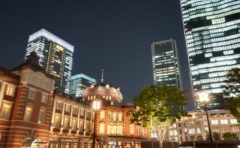- From the city to nature. Various autumnal spots in Tokyo
- Expected best time to see autumn leaves in 2019, slightly later than normal
- Autumnal spot with light-up and event
- Knowing those who know it. A famous spot for autumn leaves
- A famous spot of autumn leaves for adults to enjoy
- Colored leaves famous place to enjoy nature
- Autumnal spots in the park
From the city to nature. Various autumnal spots in Tokyo
Speaking of colored leaves, you tend to think of the mountains, but there are many colored leaves spots in Tokyo. Spots that are often overlooked, such as a garden unique to the city surrounded by high-rise buildings, and a park rich in nature that cannot be thought of as a city center, will be dyed in autumn colors, and this season will become even more attractive.
If light up is added, even if it is in the Yamanote Line, it feels a bit like traveling! If you go a little further, you can enjoy the autumn leaves in the great nature of Mt. Takao and Lake Okutama. The best place to enjoy autumn leaves in Tokyo is to choose your destination according to your mood.
Expected best time to see autumn leaves in 2019, slightly later than normal
In October, the temperature will be as normal as normal, so Iroha and other mountains in the northeastern part of Kanto are likely to be in full bloom.
In November, the temperature is higher than normal, and it is expected that the best time will be in plain areas such as Ueno Onshi Park.
Autumnal spot with light-up and event
Rikugien Garden
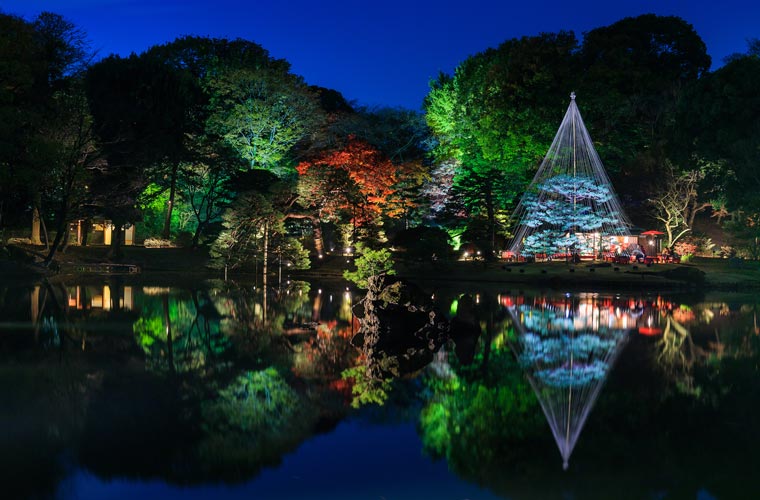
“Rikugien” is one of the Daimyo gardens that represents the Edo period and is designated as a special scenic spot in the country. From late November every year, the trees in the spacious garden begin to turn vermilion or golden. Illuminated at night, a fantastic sight different from daytime. The spectacular view from the outing, where you can see Nakanoshima and houraijima at a time, is also popular.
| Best time of year | Late November to early December |
| event | light up |
| Opening time at best time | 9:00-17:00 (Admission until 16:30) * Changes during the light-up period |
| Charge | General 300 yen |
| Access | 7 minutes on foot from Komagome Station on the JR Yamanote Line / Tokyo Metro Namboku Line |
Meiji Jingu Gaien

A tree-lined road from Aoyama Street to Meiji Jingu Gaien. The tunnel created by 146 yellow ginkgo biloba is beautiful and is one of the popular autumnal spots. The “Icho Festival” was held from mid-November to early December, and it has become a popular autumn feature in the city with more than 1.8 million visitors in recent years.
| Best time of year | Mid-November to early December |
| event | 2019 Jingu Gaien Ginkgo Festival November 15-December 1, 10: 00-16: 30 (planned) |
| Opening time at best time | November 15-December 1, 10: 00-16: 30 (planned) |
| Access | Tokyo Metro Ginza Line, Hanzomon Line,Toei Oedo Line Aoyama 1-chome Station |
Otaguro Park
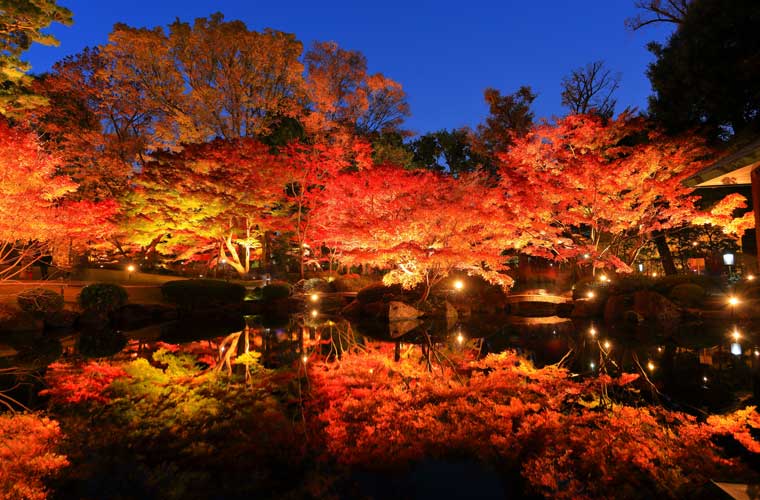
A park built on the ruins of the house of music critic Motoo Ota. There is also a memorial hall of Mr. Ota Kuro, which is registered as a tangible cultural property, and you can enjoy a stroll in the Japanese garden where water flows slowly. In autumn, it is a famous spot for autumn leaves colored by over 100 years old ginkgo trees and more than 60 maples. In late November, light-ups and concerts are held.
| Best time of year | Late November to early December |
| Event | Light up November 22-December 1, 2019 [Weekdays] 17: 00-20: 00 [Saturdays and Sundays] 17: 00-21: 00 |
| Opening time at best time | 9:00-17:00 (Admission until 16:30) * Changes during the light-up period |
| Access | About 10 minutes on foot from “Ogikubo Station” on the JR Chuo Main Line / Tokyo Metro Marunouchi Line |
Mejiro Garden
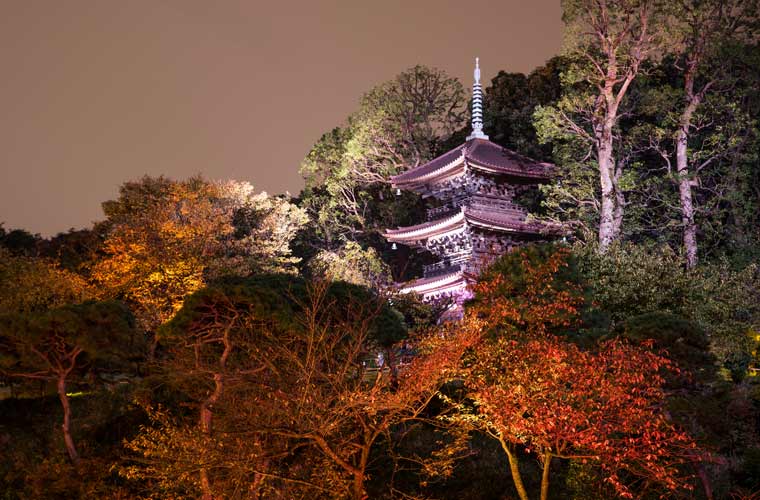
It is a pond spring excursion garden where you can walk around the pond. Sukiyori’s “Akatori-an” and a hexagonal floating hall are arranged, and plants are given to enjoy the seasonal expression of nature. Light up during the autumnal season. Colorful trees and stone towers are projected on the surface of the water, creating a fantastic sight.
| Best time of year | Late November to early December |
| Event | * Information on 2019 is unpublished November 23-December 2, 2018 17: 30-21: 00 (Admission until 20:30) |
| Opening time at best time | 9:00-17:00 * Changes during the light-up period, closed every 2nd and 4th Monday of the month |
| Charge | Free * 200 yen when light up |
| Access | About 5 minutes on foot from JR Yamanote Line “Mejiro” Station |
Koishikawa Korakuen
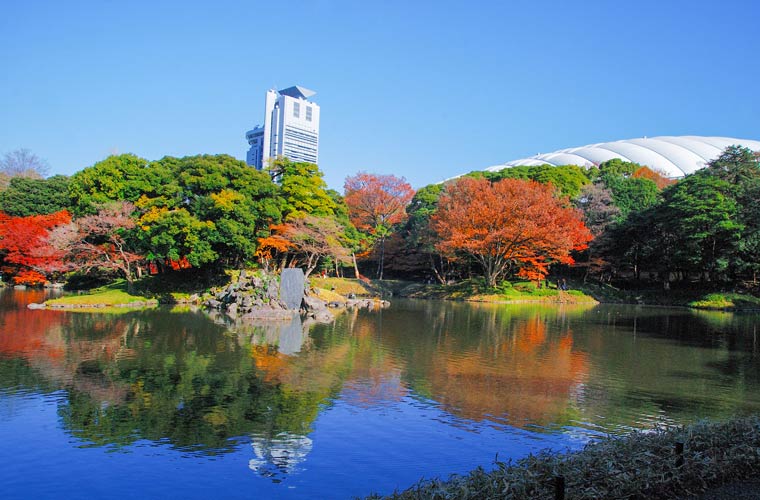
Koishikawa Korakuen is a garden near the Tokyo Dome and has been designated as a national special historic site and special scenic spot. In the large park, you can feel nature while staying in the city center and enjoy various scenery from season to season. In autumn, maple trees planted in various places are brightly colored, especially the autumn leaves of the Oyan River. The autumn leaves festival is also held at the best time.
| Best time of year | Late November to early December |
| Event | Autumn leaves festival November 15-December 5, 2019 |
| Opening time at best time | 9: 00-17: 00 (Last admission 16:30) |
| Charge | General 300 yen |
| Access | About 3 minutes on foot from Iidabashi Station on the Toei Subway Oedo Line |
National Showa Memorial Park
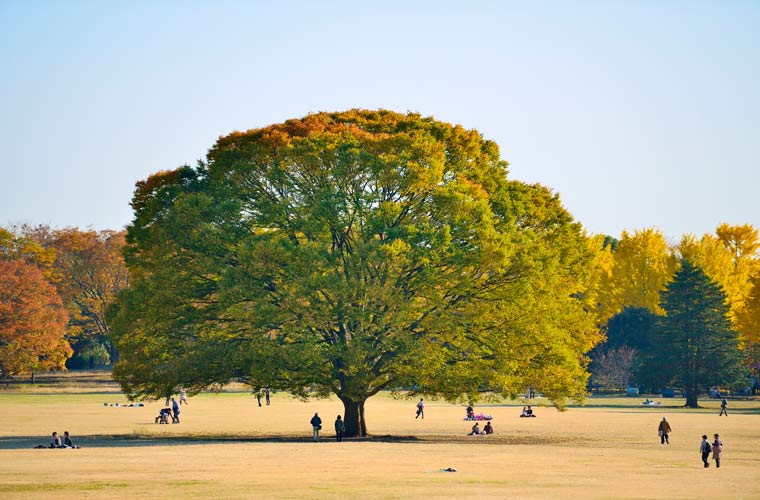
A spacious national park with a total area of about 180 hectares. There is a park train in the park, and leisure facilities such as the largest pool in the Tokyo metropolitan area and a barbecue square are available. Japanese gardens with beautiful autumn leaves and ginkgo trees lined along the canal (200 meters) are popular spots for viewing autumn leaves.
| Best time of year | From early November to late November |
| Event | Autumn leaves festival November 2-November 24, 2019 |
| Opening time at best time | 9: 30-16: 30 |
| Charge | Adult (15 years old and over) 450 yen (children (elementary and junior high school)) free |
| Access | About 2 minutes on foot from JR Ome Line Nishitachikawa Station |
Mt. Takao
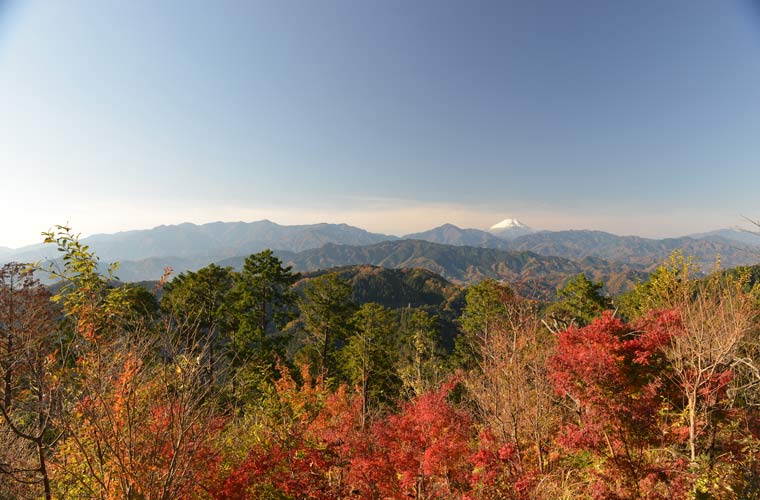
Mt. Takao is easily accessible from the city center and is visited by many people throughout the year. One of the attractions is that you can enjoy viewing autumn leaves and climbing at the same time. You can go up to the mountainside with a cable car or lift while looking at the colorful trees. From the top of the mountain, you can see the buildings in the city center and to Mt. Fuji when the weather is nice.
| Best time of year | Mid-November to late November |
| Event | Mt. Takao Maple Festival November 1st to November 30th, 2019 * Saturdays, Sundays, and |
| Opening time at best time | 10:00 to 16:00 |
| Access | About 5 minutes on foot from Keio Takao Line “Mt.Takao Entrance” station (to the cable car platform) |
Mitake Valley
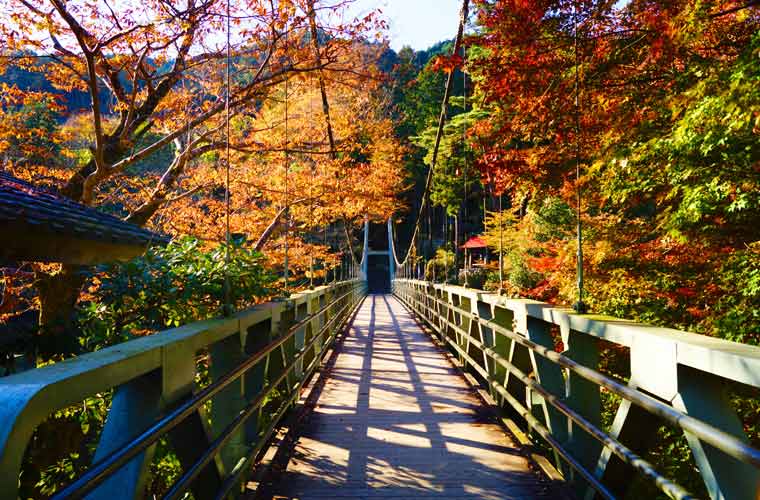
Mitake Valley that extends from Mitake Station to the middle of Sawai Station and Gunba Station. There is an approximately 4 kilometer promenade where you can enjoy a walk. The large Ginkgo biloba, about 30 meters high in front of the Tamado Museum, is lit up for a limited time. The Mitake Valley is particularly beautiful in the clear stream of Chichibu Tama Kai National Park, and has been designated as one of the 100 best waters in Japan.
| Best time of year | Mid-November to late November |
| Event | Mitake Gorge Autumn Color Festival October 26-November 24, 2019 ・ Light-up of Ginko in front of Tamado Museum (17: 00-20: 00 (November 9-last day) |
| Access | A short walk from Mitake Station on the JR Ome Line |
Knowing those who know it. A famous spot for autumn leaves
The University of Tokyo

Although it is not well known, anyone can easily visit the campus of “University of Tokyo (Hongo Campus)” and enjoy the beautiful autumn leaves. As the season begins, the bright yellow leaves and golden carpet of Ginkgo trees continue from the front of the Yasuda Auditorium, the symbol of the university, to the main gate. Similarly, the ginkgo row of trees from Akamon to the School of Medicine is also worth seeing. You can enjoy the autumn leaves reflected on the water at Sanshiro Pond in the “Ikutokuen” garden.
| Best time of year | Mid-November to early December |
| Access | 7 minutes on foot from JR “Komagome Station” on the Yamanote Line and Tokyo Metro Namboku Line |
Imperial Palace Inui Street
Although it is an imperial palace that you cannot usually enter, it may be open to the public only a few times a year. Among them, “Imperial Palace Inui-dori” is popular, and you can see colorful autumn leaves on a tree-lined road about 600 meters running north and south in the Imperial Palace. The “Station Gate” along the street is a picturesque scene that blends a fine gate structure with yellow leaves. In the middle of the street, the unspoiled nature spreads around the remains of Edo Castle’s ruins, “Dorokan”, and you can see trees dyed in various colors.
| Best time of year | Early December |
| Opening time at best time | 10: 00-14: 30 (2018 example) |
| Access | Approximately 15 minutes on foot from Tokyo Metro Chiyoda Line “Nijubashi-mae Station”, Tokyo Metro Mita Line “Otemachi Station” |
Kuhonbutsu Joshinji Temple
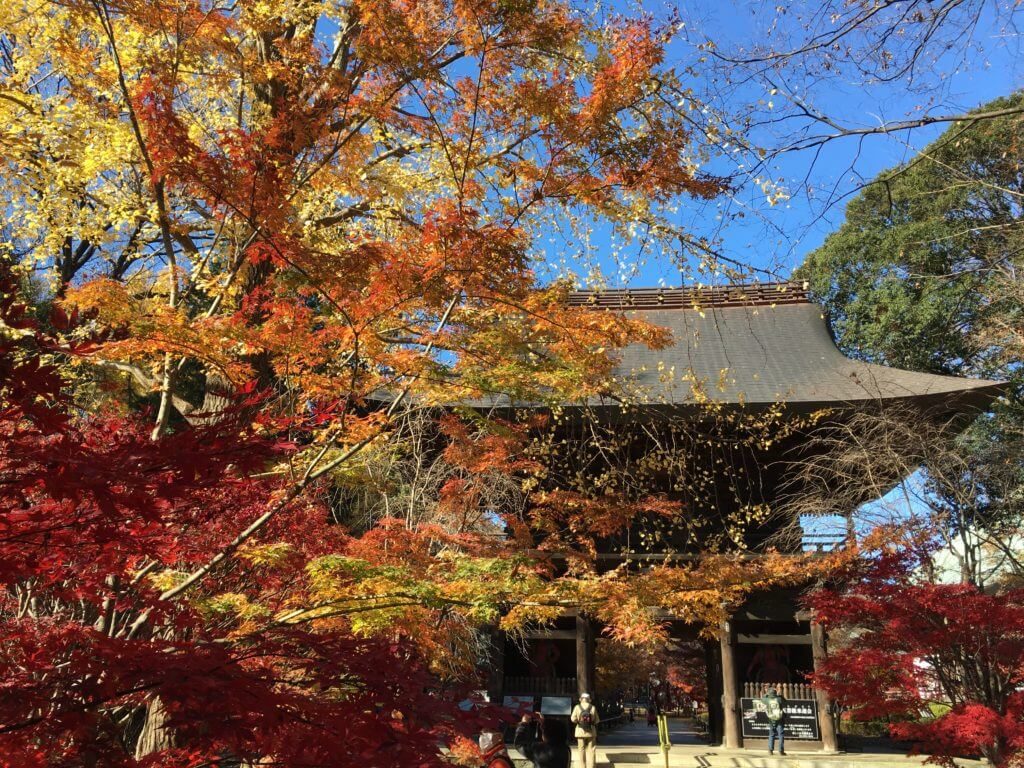
Kuhonbutsu Joshinji Temple is surrounded by a majestic atmosphere and silence. The autumn leaves that harmonize beautifully with Japanese landscapes such as the approach to the shrine, the statue of Nio, and the main hall are popular. The 700-year-old kayak tree and the ginkgo tree standing beside the main hall are designated natural monuments in Tokyo. Vividly colored figure is impressive. From the main hall, you can see two kinds of gardens, the Karesansui and the frame garden, and the scenery that becomes a picture spreads.
| Best time of year | Late November to early December |
| Opening time at best time | 6: 00-17: 00 (Monday closes at 16:50) |
| Access | Approximately 4 minutes on foot from “Kuhonbutsu” station on Tokyu Oimachi Line |
Jindai Botanical Park

One of the largest botanical parks in Japan with 100,000 trees of 4,800 types. You can see the autumn leaves of Metasequoia on the pond and the green ginkgo near the “ Kaeden-en ” and “ Hanamo-en ” where about 45 species such as Japanese maple and Japanese maple are planted, and the autumn leaves reflected on the water surface Contrast with Crimson is a beauty that will take your eyes off. In addition, you can enjoy the autumn leaves of various trees such as maple, goby, lily, wig, raccoon, and azalea.
| Best time of year | From early November to late November |
| Opening time at best time | 9: 30-17: 00 (Last admission to the main garden until 16:00) |
| Charge | Adult 500 yen, Junior high school student 200 yen |
| Access | From Keio Line “Chofu” Station, take the Odakyu Bus to Kichijoji Station or Mitaka Station, get off at “Kindai Botanical Park” stop, about 1 minute walk |
A famous spot of autumn leaves for adults to enjoy
Hamarikyu Garden
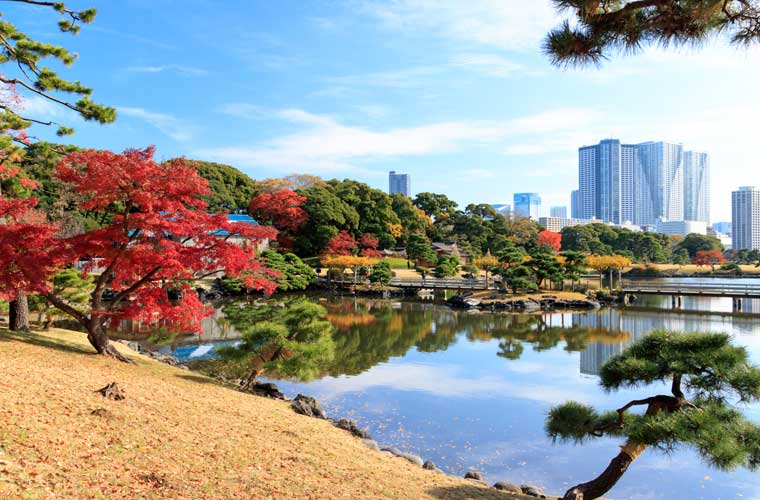
The only garden in Tokyo with a seawater pond. The feature of the pond is that it changes the taste of the pond by guiding the seawater. Although it is a city building in the surrounding area, it is a spot that retains the image of a typical Daimyo garden from the Edo period.
| Best time of year | Mid-November to early December |
| Opening time at best time | 9: 00-17: 00 (Last admission 16:30) |
| Charge | General 300 yen |
| Access | 7 minutes on foot from Shiodome Station on the Toei Oedo Line / Yurikamome Line |
Hibiya Park
This is the first Western-style modern park in Japan. The park is dotted with large and small outdoor music halls, public halls, and flower beds with seasonal flowers. You can see beautiful ginkgo trees along the S-shaped garden road. The ginkgo and maple trees around the Kumogata Pond, where the crane fountain is said to be the third oldest in Japan, are also spectacular.
| Best time of year | Late November to early December |
| Access | Get off at Hibiya Subway Station and Kasumigaseki Station |
Ueno Park
There are museums and zoos in the surrounding area, and it is a famous tourist spot that is crowded with cherry blossoms in spring and colorful leaves in autumn. 1,200 cherry trees, the ginkgo tree lined to the Tokyo National Museum, the maple and zelkova along the Shinobu River and around the Kiyomizu Kannon-do, are beautifully colored. In Shinobazu Pond, you can rent a swan boat to see the autumn leaves of the cherry blossom trees from the water. The park’s symbolic statue, Takamori Saigo, is a popular photo spot. Take a picture of your memories against a golden ginkgo background.
| Best time of year | Mid-November to early December |
| Opening time at best time | 5: 00-23: 00 (no entry outside of hours) |
| Charge | – |
| Access | JR Yamanote Line, JR Keihin Tohoku Line, JR Takasaki Line, JR Utsunomiya Line, Tokyo Metro Tetsu Ginza Line, Tokyo Metro Hibiya Line “Ueno” About 2 minutes on foot |
Tonogayato Garden

Tonogayato Garden, one of the most famous autumnal spots in Tokyo. It is one of the 9 national cultural property gardens and is a migratory forest spring garden designated by the country. Located on a slope called Kokubunji cliff line, you can enjoy the scenery using the height difference. About 190 Japanese maples turn red, and the view from the “Yorei-tei”, a sukiya building on the hill, is particularly spectacular. Sit down and watch Jiro Bentenike and autumn leaves slowly.
| Best time of year | Late November to early December |
| Opening time at best time | 9: 00-17: 00 (Last admission 16:30) |
| Charge | 150 yen for general |
| Access | JR Chuo Line, Seibu Kokubunji Line, Seibu Tamako Line “Kokubunji” station about 2 minutes on foot |
Mukojima Hyakka Garden
A botanical garden that was established during the cultural bunsei period (1804-1830), when the culture of Edo townmen flourished. It is also designated as a national scenic spot and historic site. The ume planted in the early days is still famous, and in the season you can see the bright yellow plum blossoms. In addition, it is a popular spot where you can enjoy the autumn leaves of various types of trees, such as the Japanese oak, one of the world’s three largest autumnal trees, the hazel tree that is also the haiku season word, and the ginkgo and maple trees.
| Best time of year | Mid-November to mid-December |
| Opening time at best time | 9: 00-17: 00 (Last admission 16:30) |
| Charge | 150 yen for general |
| Access | About 8 minutes on foot from Tobu Sky Tree Line “Higashi-Mukoujima station” |
Colored leaves famous place to enjoy nature
Lake Okutama
An artificial lake with a surrounding area of 45 km that stretches between Tokyo and Yamanashi Prefecture. There are various sightseeing spots on the lakeside and it is popular as an oasis in the metropolitan area. The view of the autumn leaves reflected on the water from the lakeside promenade is superb! You can enjoy beautiful autumn leaves from the Okutama circuit road, the floating bridge, and the valley of the Tama River.
| Best time of year | Mid-October to mid-November |
| Access | From JR Ome Line “Okutama” station, get off at the “Okutama Lake” stop for Nishi-Tokyo Bus bound for Okutama Lake. |
Akikawa Valley
“Akikawa Valley” is a magnificent valley that extends for about 20 kilometers. In the autumn season, you can enjoy the stunning contrast of golden ginkgo, crimson maple and clear stream blue. Ishifunabashi over Akikawa is a popular spot for viewing the foliage and overlooking the river and magnificent nature. There are also hot spring facilities in the vicinity, so it is recommended to enjoy autumn leaves picking and hot springs as a set.
| Best time of year | Mid-November to early December |
| Access | Transfer from JR Musashi Itsukaichi Station and get off at “Juri Kinoshita” station, a short walk |
Todoriki Valley
The Todoriki Valley is a healing and quiet spot where you can’t imagine Tokyo. The only canyon in Tokyo’s 23 wards that stretches for about 1 kilometer, you can enjoy a walk while listening to the murmur of the river. Maples and zelkova foliage spread in the valley, and ginkgo in addition to maples around the Todoroki Fudoson. In Todoroki Valley Park, where trees grow along the slopes of the valley, the maple of the Japanese garden is brilliantly colored.
| Best time of year | Late November to early December |
| Access | About 5 minutes on foot from Todoriki Station on the Tokyu Oimachi Line |
Autumnal spots in the park
Inokashira Park
The park opened in the Taisho era and attracted more than 100 years. The park is divided into 4 areas, and you can enjoy different scenery depending on the area. It is also popular as a cherry blossom viewing spot, but it is also recommended during the autumnal season, when the Japanese maple and ginkgo are colored. The appearance reflected on the surface of the pond is beautiful, and many visitors come during the autumnal season.
| Best time of year | Mid-November to mid-December |
| Access | 1 minute walk from Inokashira Park Station on the Keio Inokashira Line |
Yoyogi park
Despite being in the middle of Tokyo, it is the fifth largest park with a sense of openness among the city parks in the 23 wards. In autumn, about 1,000 zelkova trees and many trees such as ginkgo biloba and maple trees are colored. There are also Japan’s first bird sanctuaries and observation decks, so take a stroll through the fall.
| Best time of year | Late November to early December |
| Access | About 3 minutes on foot from Harajuku Station on the JR Yamanote Line |
Kinuta Park
Located along Kanpachi-dori Street, “Kinuta Park” with a vast lawn is a popular spot for families. In autumn, you can enjoy colorful autumn leaves such as maple red, ginkgo yellow, and zelkova orange. In particular, the beautiful contrast between about 1,000 zelkova trees and evergreen trees planted on the lawn near the main gate is a must-see.
| Best time of year | Late November to mid December |
| Access | About 20 minutes on foot from Tokyu Denentoshi Line “Yoga” Station |
Mizumoto Park
“Mizumoto Park” is the largest and largest Suigo Park in Tokyo. There is “Adventure Plaza” with playground equipment such as restaurants, shops and slides, and it is recommended for children. The highlight of the autumn foliage is the tree-lined road that stretches about 1.2 kilometers of Poplar reaching about 20 meters in height and about 1,800 Metasequoia forests.
| Best time of year | Mid November to early December |
| Access | From JR Joban Line / Tokyo Metro Chiyoda Line “Kanamachi” Keisei Bus (to Togasaki Yard or Nishimizugen Sanchome) “Mizumoto Park” stop, about 7 minutes on foot |
Fuchunomori Park
A secret spot known as a famous spot for autumn leaves, especially in the local area. You can see the foliage of a variety of trees including konara, kunugi, maple, cherry blossom, zelkova, and azalea. Above all, the autumn leaves of the “Japanese garden” divided into the east and west across the long road are a must-see! You can enjoy the artistic scenery that the Japanese maple and zelkova colors and beautifully shines in a large pond. There are shops, toilets, barbecue squares and playground squares in the park, so you can spend a day with your family.
| Best time of year | Late October to mid November |
| Access | About 10 minutes on foot from Keio Line “Higashifuchu” station |




